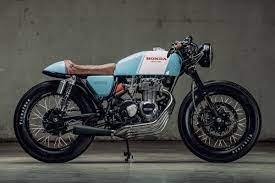In the world of motorcycles, few styles evoke the same sense of rebellion, freedom, and style as the iconic cafe racer. Originating in 1960s England, the cafe racer movement has seen a resurgence in recent years, capturing the hearts of motorcycle enthusiasts worldwide. This article explores the essence of the cafe racer, its history, and the enduring appeal that continues to draw riders to this unique style.

The Birth of the Cafe Racer:
The term "cafe racer" was coined in the early 1960s when a group of British motorcyclists began modifying their bikes for speed, agility, and a sleek, minimalist aesthetic. These riders frequented cafes and sought to create motorcycles that could outperform the competition on both the road and the race track. Stripping away excess weight, upgrading engines, and adopting distinctive low-slung handlebars, these machines became the first cafe racers.
Key Features of a Cafe Racer:
Sleek and Minimalist Design: Cafe racers are characterized by their minimalist design, often featuring a slim, elongated profile. The goal is to reduce unnecessary bulk, enhancing both speed and agility.
Clip-On Handlebars: Positioned lower than traditional handlebars, clip-ons contribute to the racer's aggressive riding posture and improved aerodynamics.
Rear-Set Footpegs: Placed further back to encourage a forward-leaning stance, rear-set footpegs optimize weight distribution for better handling during high-speed maneuvers.
Single Seat: Cafe racers typically feature a solo seat, emphasizing a streamlined look and reinforcing the bike's focus on speed rather than passenger comfort.
Modern Resurgence:
While the cafe racer movement saw a decline in the 1970s, it experienced a resurgence in the 21st century, fueled by a new generation of riders seeking a blend of classic aesthetics and modern performance. Motorcycle manufacturers responded to this demand, producing factory-built cafe racers that retained the spirit of the originals while integrating contemporary engineering and technology.
Customization and Individuality:
One of the enduring charms of the cafe racer lies in its potential for customization. Many riders take pleasure in transforming a standard motorcycle into a unique expression of their style. From custom paint jobs to performance upgrades, the cafe racer ethos encourages individuality and a connection between rider and machine.
Conclusion:
The cafe racer, with its rebellious roots and timeless aesthetic, continues to captivate riders around the world. Whether it's the thrill of the open road, the camaraderie of like-minded enthusiasts, or the opportunity for personal expression through customization, the cafe racer remains a symbol of freedom, speed, and the enduring spirit of motorcycle culture.
